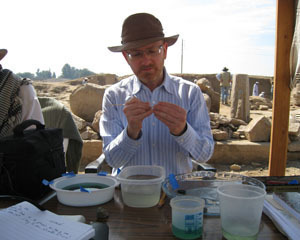Arriving on site
My first day on site was Saturday, February 9th and I’m amazed at how quickly the week flew by. One of the things I did right away was walk around the entire precinct with Mary, who explained the layout and history of the excavation. It was great to actually walk around and locate features that I’ve only read about or seen in pictures. Richard, Bill, Elsie, Jaap and Ben have also been bringing me up to speed on various aspects of the site and sharing stories and anecdotes of seasons past.
In addition, I met my Egyptian colleagues for the first time including Khaled Mohamed Wassel, the Egyptian conservator on site who has been doing an admirable job of consolidating the carved sandstone blocks in the west wall of Chapel D, and supervising the master mason, Mohahamed Gharib and his team in rebuilding the wall. They’ve all been attempting to teach me a few words of Arabic with often humorous results.


I set about surveying my conservation supplies, and examined the small finds from this season, including a group of about forty coins. Pictured above is one of the first coins I cleaned mechanically with brushes and dental tools that shows the head of a Roman emperor yet to be identified. In the other picture I’m cleaning another coin with the pointed end of a wooden skewer after softening the outer layers of corrosion in a chemical solution of 10% EDTA (ethylene diamine tetra acetic acid) in water made basic with ammonia. Uncovering legible details on heavily corroded coins requires a steady hand and a lot of patience but if successful can aid in dating the area the coins were found in.

As Mary mentioned in her most recent blog, I was also occupied this week with a very badly deteriorated, carved limestone block pictured above that is significant because it has the name of Montuemhat on one face. The block, originally part of a doorjamb, was found upside down and reused in a later doorway within the Taharqa gate. In order to continue the excavation of the gate, the block had to be moved as soon as possible. The stone though was so badly deteriorated due to damage from soluble salts in the soil that it was really just a loose pile of fragments held together by wet earth.

In order to stabilize the stone before its removal it was allowed to dry out somewhat before it was injected with Sika epoxy to strengthen its internal structure. The exterior surfaces were then faced with layers of cotton gauze, shown here, impregnated with a dilute solution of Acryloid B-72 acrylic resin that encased the top and sides and provided additional support.

After the adhesive dried, the earth underneath the block was carefully excavated around the perimeter until the block could be lifted slightly with nylon straps to free it. Here, the crew is carefully lifting the block onto a wooden support, afterwards transporting it to a nearby mastaba where it will be displayed. The operation was a success with nothing lost from the block during the move, and now I can begin to remove the cotton gauze facing.

John is a conservator of sculpture and decorative arts at the Detroit Institute of Arts where his responsibilities include all aspects of the examination, preservation, and treatment of sculpture and decorative arts in the permanent collection, including Ancient, European, Asian, African, Oceanic, American, and Contemporary art. He received his M.A. in conservation from the State University College at Buffalo in 1990. His field experience has included the treatment of the limestone sculpture on the west front of Wells Cathedral in England, treatment of the sandstone frieze on Boston’s Trinity Church, and the restoration of ceramics excavated at the site of the former Chinese Imperial kilns in Jingdezhen, China.
